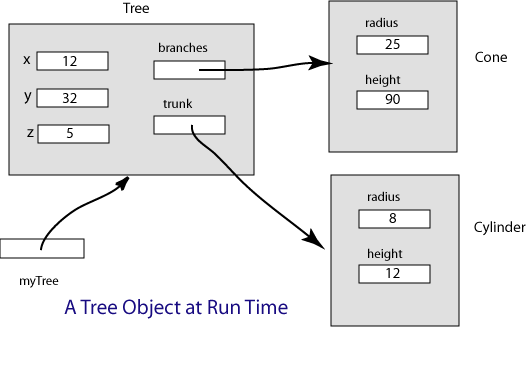Each instance variable is a reference variable.
One can point to a Cone object
the other can point to a Cylinder object.
(But the objects do not exist until they are constructed later in the constructor for Tree.)
public class Tree
{
// instance variables
private double x, y, z;
private Cone branches;
private Cylinder trunk;
...
}

A Tree is composed of a Cone and a Cylinder.
This is coded by including a reference variable for each of these object types.
At run-time there will be three objects: a Tree object,
a Cone object,
and a Cylinder object.
Even though there are three discrete objects, you think of the tree as one thing composed of three smaller objects. When the program is running these are implemented as three separate blocks of main memory and may be at widely separated locations.
Object composition is sometimes called a has-a relationship between objects:
Tree has-a ConeTree has-a Cylinder
It is tempting to think that the Cone
and Cylinder objects are directly part of the Tree object:
that a complete Cone object and complete Cylinder object
are embedded in the Tree object.
Avoid that thought! All that a Tree object has is a reference to a Cone
and a reference to a Cylinder.
Unfortunately, programmers (and books) often speak as if objects directly contained other objects.
In the real-world, this is true. A tree directly consists of branches and trunk.
But in Java, a tree consists of a pointer to the branches and a pointer to a trunk
(and some variables of an integer type.)
Think about what the constructor for a Tree looks like.
public class Tree
{
// instance variables
private double x, y, z;
private Cone branches;
private Cylinder trunk;
// constructor
public Tree( ? )
...
}
Constructors for Cone and Cylinder look like this:
public Cone ( double radius, double height ) public Cylinder( double radius, double height )